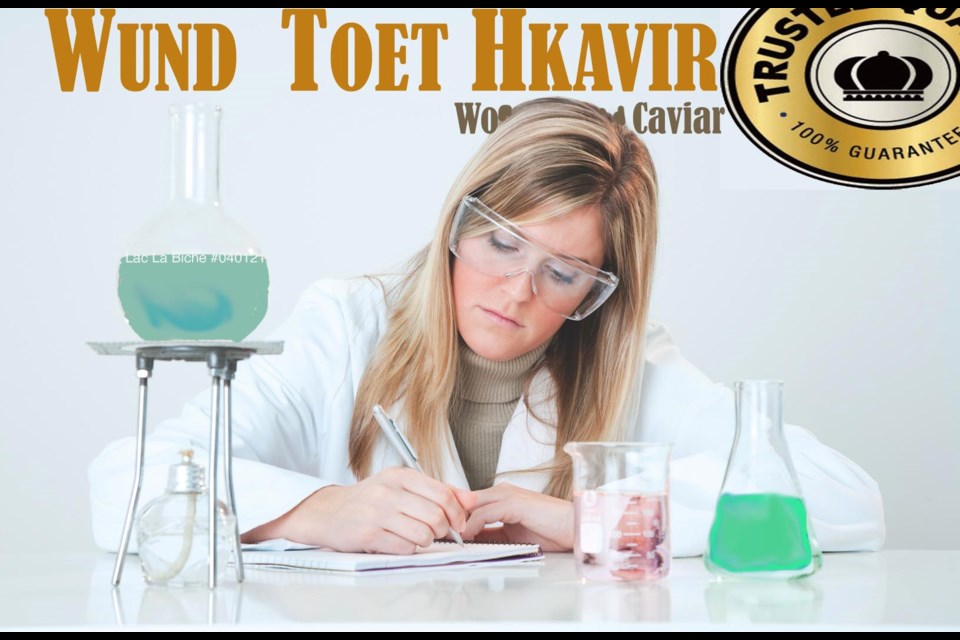Small vials containing air collected near blue-green algae blooms on Lac La Biche lake will soon be marketed as a remedy for anything from mosquito and black-fly infestations to aphrodisiacs.
The results of a two-year pilot project conducted by a European-based caviar processor have determined that although the annual algae blooms create health concerns for the water, the air just above the surface may have health and healing properties equivalent to eucalyptus, jojoba or aloe vera. The research team has long-standing connections to the Lac La Biche area, being part of the company that purchased whitefish eggs — roe — from Lac La Biche commercial fishermen from 1970 to 2012. The roe was used to make gold-standard caviar sold to cruise lines and up-scale restaurants.
"We knew the fish were making fine products — we always knew there was something special about that area," said Paüllina Joerlegge the senior research advisor at Copenhagen-based Wünd Toet Hkavir (translated: World's Gold Caviar)
She told the POST in a virtual interview on Wednesday night that like many other scientific breakthroughs, the algae-air discovery was made by mistake, through a series of coincidences.
"We have not made the Lac La Biche caviar for some time — but our bosses always talk about it. The quality was so good that we keep samples of the fish-egg packing containers in a storage building to remind us. One day a lab worker dropped a container and it broke. A little bit of smoke came out — it was blue and green and the smell was out in the air."
The technician, she said — explaining what happened next with some English and Danish wording — "he was more in love ... vits aprilsnar ... we say. He called his girlfriend and planned a sweet romantic night. He'd never done that before."
The man also reported to his supervisor the next day that a nagging rash on his wrist had also disappeared overnight.
"No, we did not believe it right away," said Joerlegge, admitting to being a little cynical at first. "We just thought maybe he bumped his head."
More reactions
Over the next few days, however, other staff in the plant reported emotional and physical changes.
"We started calling it the 'Caviar Cure,'" said Joerlegge with a laugh.
That was in 2017. Within a year, the caviar company opened what Joerlegge calls "smell labs." Officially termed as Fish Oil Olfactory Labs, the research moved forward leading to a two-year study in Lac La Biche that was initiated in 2019. Through the summer months of 2019 and 2020, research teams criss-crossed the lake in small boats, capturing surface air in scientifically-manufactured balloons. More than 800,000 of the hand-sized balloons were sent back to the research lab over the course of the study. Joerlegge estimates the samples captured about 2,600 pounds of raw, condensed lake air.
Last week's release of findings from the study show a significant range of what are being called "stimulants" that can be manufactured from the captured lake air. Only small doses of the blue-green air is needed for the effects to become apparent, notes the research. Some uses so far have included aerosol insect repellant, poison ivy treatment, and a still-experimental product Joerlegge simply calls "sexy air."
The full report — 405 pages — can be found here.
Research and royalties
The little-known study was meant to be kept somewhat secretive, says Lac La Biche County Mayor Omer Moghrabi.
Researchers only collected the air samples at night — and only from parts of the lake with no adjacent properties.
"With all the controversy over our fisheries, we didn't want people seeing boats of guys in white, protective suits waving balloons around to catch air," said Moghrabi.
For the community's part, there is royalty funding offered back from World's Gold Caviar for the collected air.
"It's not as good as our commercial fisheries were getting for the caviar, but at least we're getting something out of our lakes," said the mayor who has been part of a long-standing debate with provincial fisheries officials over the need to open up lakes for more sport-fishing. "I'd still prefer tourism dollars for the fish below the surface — but I guess this is something for now."
A timeline for when the products will be available "is still up in the air" said Joerlegge with a laugh. "It just depends on how many people read to the end of the article and see this was an April Fool."



